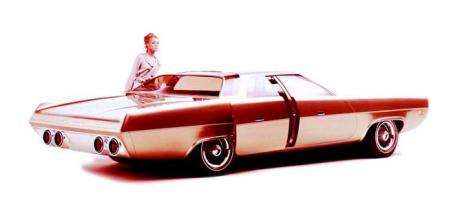1969 Chrysler Concept 70X
Safety as a marketing concept for cars? Well, Richard Heseltine reckons we have Ralph Nader to thank for that. This month Richard examines a concept vehicle that was a direct result of the sudden interest in vehicle safety after Nader’s campaigning…
Richard Heseltine From here to obscurity
Blame Ralph Nader for the emergence of car safety as a selling point over, you know, something sexy like horsepower. It’s hard not to. His explosive book Unsafe at Any Speed: The Designed-In Dangers of the American Automobile exposed the motor industry’s apparent disregard for the well-being of those driving its wares; that its products crumpled like beer cans in accidents; that they didn’t handle as well as they might; that the bottom line counted for more than the lives of their customers.
The irony is that this exposé probably wouldn’t have been so widely publicised had Detroit’s Big Three not tried to smear the crusading lawyer (and so ineptly). His work directly (and indirectly) led to the implementation of improved safety standards, but only after Congress and the major US motor brands had locked horns.
The late Sixties witnessed the emergence of American concept cars which trumpeted safety features and did so loudly. Suddenly, being seen to care mattered.
One of the least well-remembered of these was the Chrysler Concept 70X, this large sedan having been unveiled at the 1969 Chicago Auto Show. While no details were revealed about the basis for the car, it was suggested in period that the foundations may have been borrowed from a New Yorker. However, the car’s signature feature was its unusual door arrangement. As the promotional material boasted in period, if not always coherently: “One of the new and most exciting features of the Chrysler Concept 70X is the parallelogram hinges on the doors. Rather than swinging outward like convential [sic] doors, the doors open outward and swing parallel to the car.”
It went on to add: “They open some 15 inches from the side of the car and are ideal for tight parking situations. The car, executed in fibre glass [sic], is built along the general body dimension [sic] of a current production Chrysler car.”
As the firm’s PR machine was quick to point out, this ‘Idea Car’ was effectively two concept cars in one, because the design was being trialled in as many configurations: on the left-hand side there were two doors, suggesting it was a four-door sedan. On the right-hand side, there was one immensely long door and the overall look of a two-door coupe.
The press release added: “…the door of the two-door model is 71 inches long, which allows the passenger to get in and out of the rear seat without folding down the front seat”. Inside, there was another revolutionary feature; one that was mounted behind the rear seats. A small ultrasonic device swept an area of 50ft to the rear in three distinct zones: the left and right lanes and directly behind. If a vehicle entered one of these zones, a red light sited on the interior mirror was illuminated. This gave the driver 0.4 of a second warning before they were rear-ended.
Or, to put it another way, just long enough to utter an expletive before being propelled into something immovable. Such proximity alarms are now commonplace, mind, while the door arrangement was later adopted for Chrysler’s range of minivans.
As for the fate of the Concept 70X, we suspect it went the way of most other show queens of the period and was scrapped.
Sliding door concept… Well, she looks a bit unsureaboutitall! ...would see reality in…… Chrysler minivans in the 80s.


